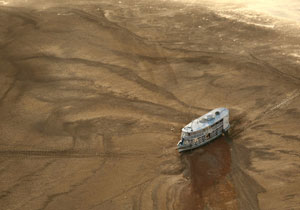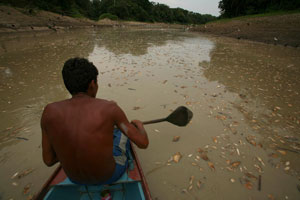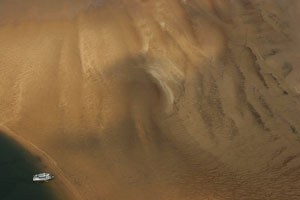 |
 | |||||||||||||
The Amazon Drought
|
 |
||||||||||||
|
I am in Seattle, my home for the last four years, having a coffee at my favorite spot, the C&P. While I'm thinking that the photo business has been kind of slow for the last two weeks, a short e-mail from Greenpeace changes it all. The Amazon is experiencing one of the most severe droughts in its entire history: large parts of the rainforest are at their driest ever and Greenpeace wants me to document it.
Off to Glazer's camera store, the perfect excuse to pick one of the new Canon 5Ds I want. Later, after 30 long hours, I am landing in Manaus Airport. The 99 percent humidity and the temperature of over 100 F hits you like a wall when the airplane door opens.
Soon enough I find myself traveling by inflatable boat on the Amazon River towards Lago Rei, one of the areas that has been more severely affected by this terrible drought. Of its 12,000 hectares (29,652 acres) that feed more than 40 small lakes, Rei is almost dry. There are only 1,000 hectares (2,471 acres) of water left. Huge amounts of dead fish are bedding along the shallow margins, contaminating the water and increasing the risk of epidemic diseases. Urubu vultures by the hundreds are having a feast.
Thousands and thousands of dead fish, covered by maggots, are floating all over the small river. The stench is terrible, and the filthy water leaks through the wood planks of our canoe, soaking my boots and camera bag (luckily, a waterproof one). I am starting to realize the impact the drought is having. Fish is the major source of protein for the population and one of the pillars of the local economy. Future fish stocks will be seriously compromised.
According to the Amazonas State Government, about 32,000 community families are isolated in different cities and up to 100,000 families are deeply suffering with the difficult access to their villages.
The images I am getting are strong, but I am still focusing on what has already been done. When I arrived in Brazil the story was already in the media. Finding images that will push the story further is my main goal.
Everybody on board is on the lookout for boats stranded on the huge sandbanks that are appearing all over the place. We find several small canoes abandoned on dry riverbeds, but I need a stronger image.
One afternoon at dusk, near Bareirinha, we locate a big riverboat sitting on a sand bar. The crew has managed to hold it with short beams carefully positioned on its sides. It's sitting high and dry in what looks like the Sahara desert. I wonder how long they have been like that. I can see people emerging from their cabins waving at us. This is the photo I had in mind, but it's too dark already. We will end up landing in Santarem and will try again tomorrow.
Helping to raise awareness of the problem is very rewarding and becomes the prime motivator for my work. Scientists are blaming the devastating drought currently affecting the Amazon rainforest on a vicious cycle created by the combined effects of global warming and deforestation.
The Amazon basin contains up to 30 percent of the terrestrial biological diversity. It is the largest tropical forest on the planet, almost continental in scale. It is a vast, remote and mysterious rainforest teeming with undiscovered plant and animal life and home for hundreds of indigenous groups.
In the last 10 years, the Brazilian Amazon alone has lost more than 77,000 square miles of pristine rainforest, an area the size of England and Scotland together.
© Daniel Beltrá
Dispatches are brought to you by Canon. Send Canon a message of thanks. |
|||||||||||||
Back to December 2005 Contents
|
|




